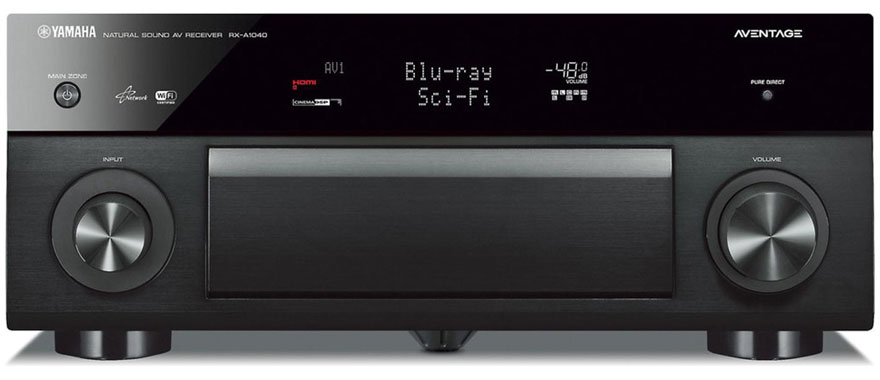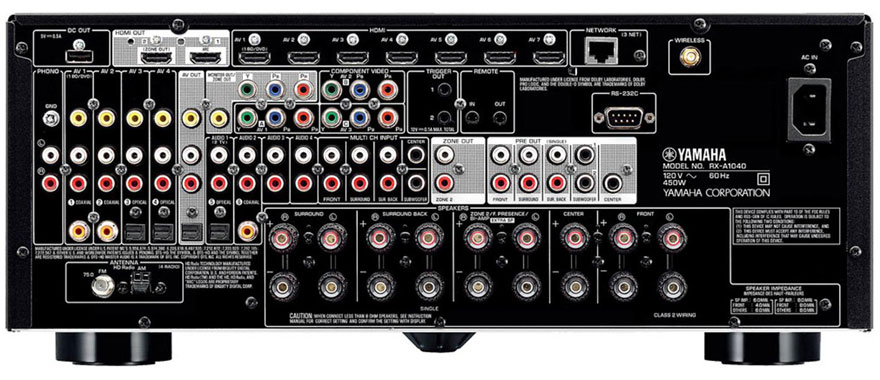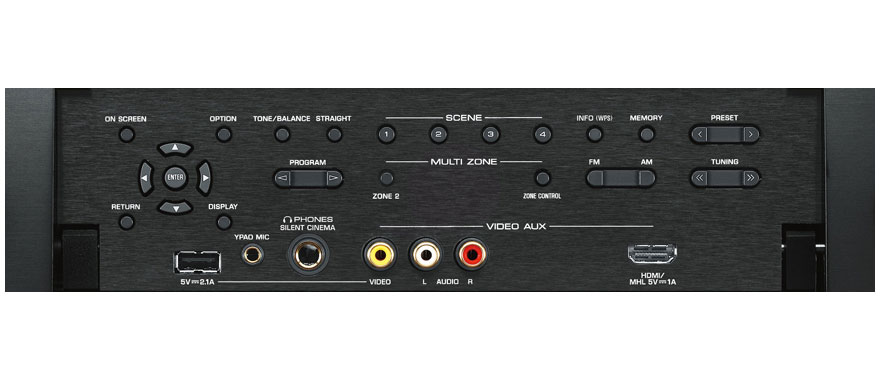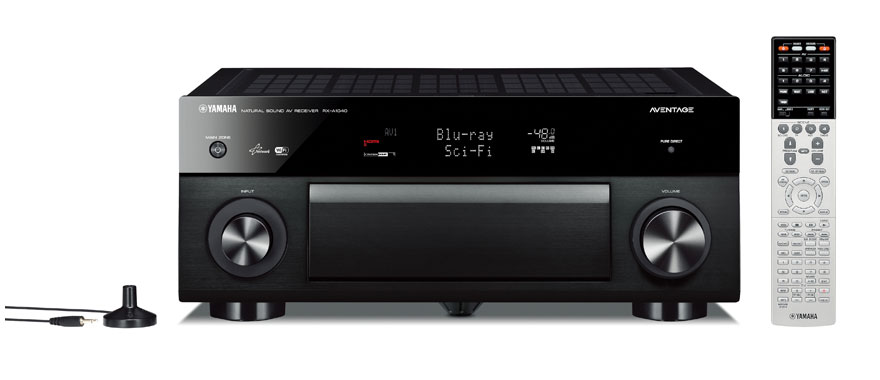If you are going to spend more than $1,000 on a home theater receiver, you better have high expectations because there are a lot of manufacturers gunning for that price point. It is that level where these companies can really go all out with the features and audio technologies. Achieving this isn’t just as easy as making movies and music sound great either. Even if that is the one thing you care about, home theater receivers are designed to last for years and you don’t want to find yourself changing to another model just because you suddenly need a feature you didn’t need before. A high-end receiver should have that Swiss-army knife appeal and the Yamaha RX-A1040 seems to be up for the challenge.
Design
The RX-A1030 was a fantastic home theater so it makes perfect scene to keep the design of the RX-A1040 the same. When it comes to Yamaha receivers, spending more means getting a cleaner design. The top part of the front panel is clean, black and serves as the onscreen display when turned on. The only noticeable difference between the RX-A1040 and RX-A1030 is the Wi-Fi logo placed next to the power button. The bottom half has a brushed aluminum look with a large door between the two knobs that are normally found on home theater receivers these days.
Opening this door reveals a multitude of buttons and connection ports including the 4 SCENE buttons which act as customizable input source switches and the usual composite, HDMI and USB ports. There is a pretty big gap between the video aux and HDMI ports because the older RX-A1030 model had an optical input. This isn’t a big deal since the front HDMI port has the latest HDMI specification with MHL and is more versatile than ever.
The back of the Yamaha RX-A1040 really shows where all that extra money is going. Compared to the cheaper RX-A840, this receiver has more analog audio and video inputs and an extra set of component video, optical and coaxial inputs. It also has two 12v trigger outputs rather than just one. Internally, the RX-A1040 is also better designed than the RX-A840 thanks to the added bottom frames resulting to a more rigid chassis and a heat sink with anti-thermal and anti-vibration properties. Combined with the Anti-Resonance Technology wedge underneath the receiver, the Yamaha RX-A1040 is clearly designed with studio-grade audio quality in mind.
Below is the back panel layout. Click on image to enlarge for a clearer view.
Features
Although the RX-A1030 was a pretty good choice for home theater enthusiasts, it wasn’t exactly futureproof. The lack of Wi-Fi meant that it needed physical link to a router to establish a wireless connection with mobile devices. This old receiver had 4K support but newer 4K displays are coming out with new support for upcoming standards. The RX-A1040 addresses both of these issues by incorporating Wi-Fi and equipping each HDMI port with the latest 2.0 specification. The Wi-Fi functionality sounds like a nice little convenience as you can now place the router further away from the receiver but it also makes the router completely optional if all you care about is the mobile interaction.
The new Wireless Direct feature essentially turns the Yamaha RX-A1040 into a router where you can connect multiple mobile devices to the receiver. While you lose the receiver’s ability to independently stream audio online, the AV Controller App that is used to operate the receiver from a mobile device remotely works to the fullest. It enables the two most important things about Wi-Fi which are remote configuration and local music streaming. Streaming from an iOS or Android device is as easy as selecting the track you like within the app and streaming it instantly. AirPlay and HTC Connect for Apple and HTC devices respectively work too. This feature has the simplicity of Bluetooth pairing without the limitations and that explains why the RX-A1040 lacks Bluetooth. If you have a Spotify Premium account, you can also use the Spotify app on your mobile device to stream tracks directly to the receiver. Otherwise, you have to stick with the typical router setup which also allows the receiver to pull content from Pandora, Rhapsody and several other music streaming services.
HDMI 2.0 isn’t much of a big deal now but it will be once more 4K media pours out from content providers. The biggest deal of this specification has to be the 4K Ultra HD 50/60 Hz pass-through as it results to smoother high-definition videos. The added support for RGB, YCbCr 4:2:0, YCbCr 4:2:2 and YCbCr 4:4:4 is just icing on the cake.
Yamaha didn’t bump up the specifications of the Yamaha RX-A1040 but it does add a few other improvements over its predecessor. The new gapless playback feature eliminates that silent interval that plays between tracks making it a fine addition for mixtape and classical album owners. Lossless fans will also appreciate the added support for Apple’s ALAC format. The RX-A1040 still uses the same ESS Technology ES9006 SABRE Premier Audio DAC like last year’s model but you could make the audio quality on the low-range a bit better with the new Extra Bass feature. This feature even works with small front speakers and should boost the performance of any connected subwoofer.
The RX-A840 serves as a cheaper Yamaha receiver option and it has many of the aforementioned new additions present in the RX-A1040 but the Yamaha RX-A1040 is more powerful and versatile. The 2 HDMI outputs in the A1040 can be used as separate Zone outputs while the A840 can only use them as mirrored outputs. There are also more SCENE buttons on the GUI in the RX-A1040 opening up even more zone management possibilities. This is the receiver to get if you want different HD audio and video sources in different rooms. The symmetrical power amplifier layout which improves signal-to-noise ratio is also exclusive to the Yamaha RX-A1040 and higher-end Yamaha models.
Bottom Line
If you don’t need anything more than a 7.2-channel receiver, the RX-A1040 has just about everything you need. It is ready for today’s equipment and all the other cool stuff that will be announced in future years. That is enough to be convinced to spend $1,200 without hesitation.
Update: There is a newer model > Yamaha RX-A1050




